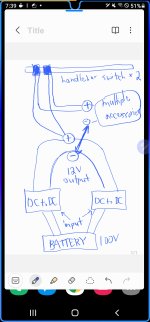Hi guys
Im wiring a lot of accessories to (2) separate DC to DC 100v to 12v converters.
I am using 2 in order to share the load on the accessories. I have a horn, a lot of lights etc.
I also have 2 separate on/off switches on the handlebar
My question is, in the diagram I drew up, will the handlebar switch wires (which are very thin) make any difference when turning on and off the accessories? I decided to put the handlebar switch wires on the positive 12v side of the converters.
This is my main concern
Also would that be the appropriate place to put the turn on wires?
Hope you can follow my diagram.
Thanks!
Im wiring a lot of accessories to (2) separate DC to DC 100v to 12v converters.
I am using 2 in order to share the load on the accessories. I have a horn, a lot of lights etc.
I also have 2 separate on/off switches on the handlebar
My question is, in the diagram I drew up, will the handlebar switch wires (which are very thin) make any difference when turning on and off the accessories? I decided to put the handlebar switch wires on the positive 12v side of the converters.
This is my main concern
Also would that be the appropriate place to put the turn on wires?
Hope you can follow my diagram.
Thanks!



